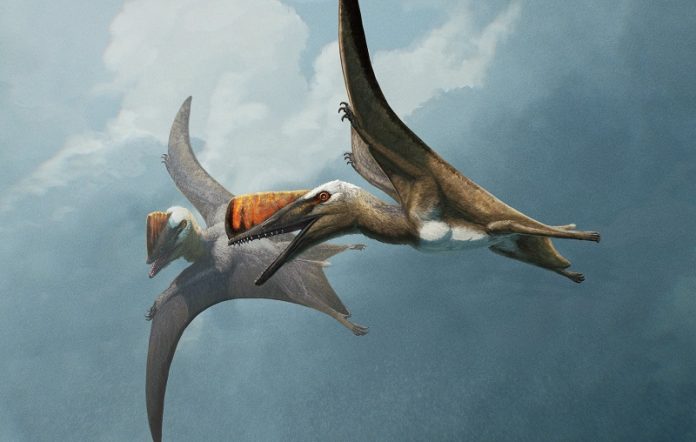
Pterosaurs, the extinct flying reptiles that soared alongside dinosaurs, had an incredible evolutionary journey.
These creatures ranged from small, eagle-sized species to giants with wingspans of 10 meters.
For years, scientists have puzzled over how early pterosaurs evolved into the much larger and more specialized pterodactyloids. Now, a new fossil discovery is shedding light on this mystery.
Researchers, led by Dr. David Hone of Queen Mary University of London, have described a new species of pterosaur named Skiphosoura bavarica, or “sword tail from Bavaria.”
This remarkable fossil, found in southern Germany, provides critical clues about the evolutionary transition between early pterosaurs and their pterodactyloid descendants. The study is published in Current Biology.
Skiphosoura stands out because it is preserved in three dimensions, a rare occurrence since most pterosaur fossils are flattened.
Almost every bone of the specimen is intact, offering an incredibly detailed look at this species.
With a wingspan of about two meters—similar to a golden eagle—Skiphosoura had a unique short, stiff, and pointed tail, which inspired its name.
For over 200 years, scientists have categorized pterosaurs into two major groups: early non-pterodactyloids and later pterodactyloids. These groups are distinct in their body shapes. Early pterosaurs had short heads, short necks, long tails, and a short wrist bone in their wings. In contrast, pterodactyloids had large heads, long necks, short tails, and elongated wrist bones.
In the 2010s, paleontologists discovered intermediate species called darwinopterans, which showed that the head and neck changed first in this evolutionary process. However, the rest of the transformation remained unclear—until now.
Skiphosoura fills an important gap between darwinopterans and pterodactyloids. It retains the pterodactyloid-like head and neck but also shows other transitional features. Its wrist bones are longer, and its toes and tail are shorter than those of earlier species, though not as extreme as in pterodactyloids. This fossil helps scientists trace the evolutionary changes step by step, providing a clearer picture of how these flying reptiles adapted over time.
The study also updated the evolutionary family tree of pterosaurs. Another fossil, a Scottish pterosaur called Dearc, was found to sit at a different transitional stage, between early pterosaurs and darwinopterans. Together, Dearc and Skiphosoura create a nearly complete sequence of evolution, showing how features like head size, neck length, and tail reduction developed gradually.
Both Dearc and Skiphosoura were unusually large for their time, suggesting that the adaptations seen in these species may have set the stage for the gigantic sizes achieved by later pterodactyloids. These evolutionary changes helped pterosaurs become some of the most successful flying animals in history.
Dr. Hone called Skiphosoura “an incredible find” and hopes this discovery will inspire future research on pterosaur evolution. Adam Fitch, from the University of Wisconsin-Madison, added that Skiphosoura is a key piece in understanding how pterosaurs evolved and adapted over millions of years.
The fossil was carefully studied using both visible and ultraviolet (UV) light photography. This technique allowed researchers to examine fine details that weren’t visible under normal light. Stefan Selzer, a preparator on the project, noted that the specimen combined features of both major pterosaur groups, with the shortened tail being a defining trait.
The discovery of Skiphosoura offers a clearer picture of how pterosaurs evolved from small, early flyers into the massive reptiles that once dominated prehistoric skies. This fossil is a stunning example of the gradual but extraordinary changes that shaped life on Earth.



